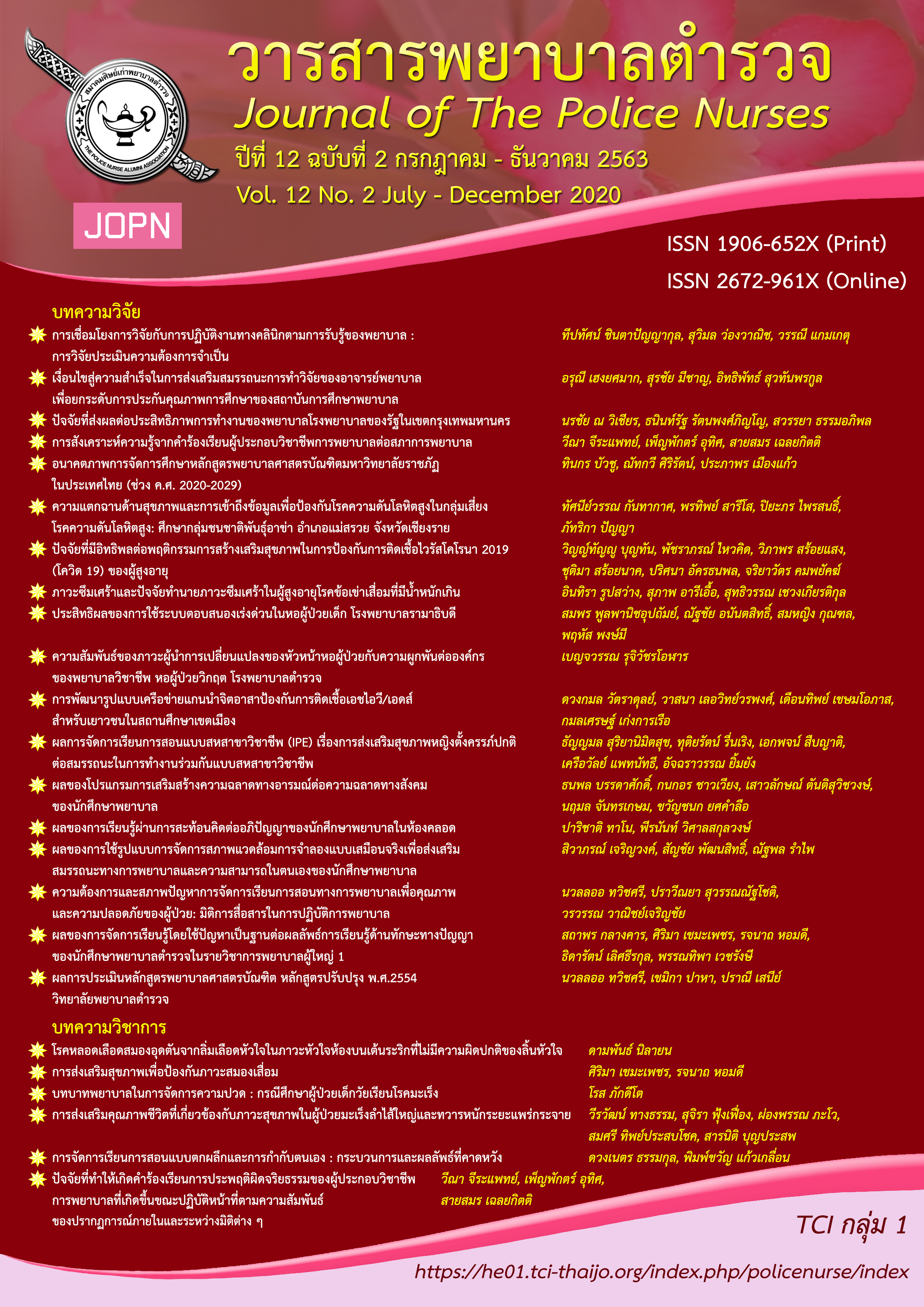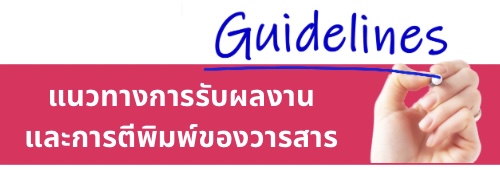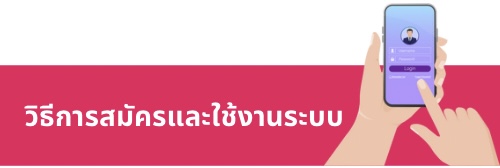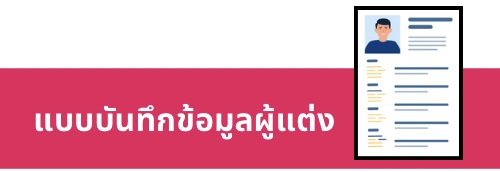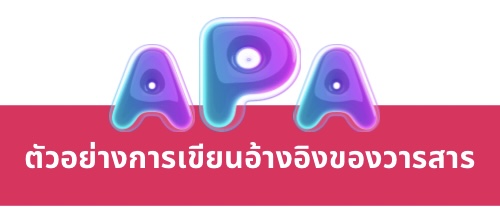ความต้องการและสภาพปัญหาการจัดการเรียนการสอนทางการพยาบาลเพื่อคุณภาพ และความปลอดภัยของผู้ป่วย: มิติการสื่อสารในการปฏิบัติการพยาบาล
คำสำคัญ:
การสื่อสารในการปฏิบัติการพยาบาล, การศึกษาทางการพยาบาล, คุณภาพและความปลอดภัยของผู้ป่วยบทคัดย่อ
การสื่อสารในการปฏิบัติการพยาบาลมีความสำคัญต่อประสิทธิภาพของการดูแลผู้ป่วย เนื่องจากการปฏิบัติงานตามบทบาทและหน้าที่ของพยาบาลมีผลโดยตรงต่อคุณภาพการดูแลผู้ป่วยและการฟื้นหายของโรค พยาบาลจำเป็นต้องได้รับการพัฒนาความสามารถสื่อสารในการปฏิบัติการพยาบาลตั้งแต่เป็นนักศึกษาพยาบาล เพื่อให้สามารถประยุกต์ใช้ความรู้และทักษะในการปฏิบัติการพยาบาลได้อย่างมีประสิทธิภาพ ลดความเสี่ยงและข้อผิดพลาดที่เกิดจากการสื่อสาร นำไปสู่คุณภาพและปลอดภัยของผู้ป่วย การสอนทางการพยาบาลจึงควรให้ความสำคัญและออกแบบให้ผู้เรียนเกิดการเรียนรู้และได้ฝึกทักษะการสื่อสาร การศึกษาวิจัยนี้มีวัตถุประสงค์เพื่อ 1) ศึกษาและวิเคราะห์ความต้องการจำเป็น และสภาพปัญหาการเรียนการสอนการสื่อสารในการปฏิบัติการพยาบาล 2) รวบรวมข้อมูลเกี่ยวกับวิธีการจัดการเรียนการสอนสำหรับเป็นแนวทางส่งเสริมความสามารถสื่อสารในการปฏิบัติการพยาบาลของนักศึกษาพยาบาล วิธีดำเนินการวิจัย ใช้การวิจัยเชิงคุณภาพ เก็บรวบรวมข้อมูลจากผู้ให้ข้อมูลสำคัญที่ได้จากการเลือกแบบเจาะจงจำนวน 30 คน โดยการสนทนากลุ่มกับพยาบาลวิชาชีพที่เป็นครูพี่เลี้ยง 11 คน พยาบาลวิชาชีพที่ทำหน้าที่ฝึกอบรม 9 คน และการสัมภาษณ์เชิงลึกกับอาจารย์พยาบาล 5 คน ผู้เชี่ยวชาญด้านการศึกษาและการประกันคุณภาพการดูแลผู้ป่วย 2 คน และผู้เชี่ยวชาญด้านเทคโนโลยีและสื่อสารการศึกษา 3 คน วิเคราะห์ข้อมูล โดยการวิเคราะห์เนื้อหาและการจัดลำดับความต้องการจำเป็น
ผลการวิจัย พบว่า 1) นักศึกษาพยาบาลมีปัญหาการสื่อสารในการปฏิบัติการพยาบาล ไม่รู้หลักการและเทคนิคการสื่อสารที่ดี จึงไม่มั่นใจและไม่สามารถสื่อสารได้อย่างมีประสิทธิภาพ มีสาเหตุจากขาดความรู้ ทักษะ และประสบการณ์การสื่อสารในการดูแลผู้ป่วยและการทำงานร่วมกับสหวิชาชีพ 2)แนวทางการจัดการเรียนการสอนเพื่อส่งเสริมความสามารถสื่อสารในการปฏิบัติการพยาบาล โดยผู้สอนเป็นผู้กระตุ้นให้ผู้เรียนตระหนักถึงความสำคัญ ให้ความรู้พื้นฐาน สนับสนุนให้ผู้เรียนศึกษาค้นคว้าด้วยตนเอง และจัดประสบการณ์ให้ผู้เรียนเผชิญสถานการณ์จริงหรือสถานการณ์จำลองในคลินิกเพื่อฝึกทักษะการสื่อสารในการปฏิบัติการพยาบาล แล้วมีระยะเวลาให้ได้ทบทวนและฝึกซ้ำ โดยใช้คอมพิวเตอร์สนับสนุนและเพิ่มช่องทางให้ผู้เรียนได้สะท้อนคิด แลกเปลี่ยนเรียนรู้ร่วมกัน สรุปและเชื่อมโยงความรู้ที่ได้เพื่อสามารถประยุกต์ใช้กับสถานการณ์ใหม่ในการสื่อสารกับผู้ป่วยและญาติ รวมทั้งเพื่อนร่วมงานในทีมสุขภาพอย่างมีประสิทธิภาพ
Downloads
เอกสารอ้างอิง
Boonnun, J., & Chayaput, P. (2009). Nurse’s role in unfavorable information “Breaking Bad News” communication to cancer patients. Thai Journal of Nursing Council, 24(3), 7-19.
Bressler, T., & Persico, L. (2015). Interprofessional education: Partnerships in the educational proc. Nurse Education in Practice, 1-4. http://dx.doi.org/10.1016/j.nepr.2015.07.004
Chaleoykitti, S., Kamprow, P., & Promdet, S. (2014). Patient safety and quality of nursing service. Journal of The Royal Thai Army Nurses, 15(2), 66-70.
Dhevapithak, D. (2016). Communication in health system. Retrieved from https://www.classstart.org/classes/19271
Foronda, C., MacWilliams, B., & McArthur, E. (2016). Interprofessional communication in healthcare: An integrative review. Nurse Education in Practice, 19, 36-40.
Finocchario-Kessler, S., Catley, D., Thomson, D., Bradley-Ewing, A., Berkley-Patton, J., & Goggin, K. (2012). Patient communication tools to enhance ART adherence counseling in low and high resource settings. Patient Education and Counseling, 89, 163-170. http://dx.doi.org/10.1016/j.pec.2012.03.020
Gu, Y., Zou, Z., & Chen, X. (2017). The effects of vSIM for nursing as a teaching strategy on fundamentals of nursing education in undergraduates. Clinical Simulation in Nursing, 13(4), 194-197.
Institute of Medicine. (2010). The future of nursing: Focus on education. Report Brief. The National Academy of Sciences, Washington: U.S.A.
Jeerapaet, V., & Jeerapaet, K. (2007). The management of patient safety concepts, processes, clinical practice guidelines. Bangkok: Eleven-colour.
Jogerst, K., Callender, B., Adams, V., Evert, J., Fields, E., Hall, T., . . . Wilson, L. L. (2015). Identifying interprofessional global health competencies for 21st century health professionals. Annals of Global Health, 81(2), 239-247.
Joint Commission International (JCI). (2018). Communicating Clearly and effectively to patients: How to overcome common communication challenges in health care. A White Paper by Joint Commission International. Retrieved from https://www.jointcommissioninternational.org/assets/3/7/JCI-WP-Communicating-Clearly-FINAL_(1).PDF
Kolb, D. A. (2015). Experiential learning: Experience as the Source of Learning and development (2nd ed.). Pearson Education, Inc., New Jersey, NJ: USA.
Kongkakul, M., & Wanpiroon, P. (2012). The cooperative learning through electronic means with the inquiry process students learn to develop analytical thinking skills. Academic Services Journal, 23(3), 79-89.
Kourkouta, L., & Papathanasiou, I. V. (2014). Communication in nursing practice. Master Sociomed, 26(1), 65-67. doi:10.5455/msm.2014.26
MacDonald, M. B., Bally, J. M., Ferguson, L. M., Murray, B. L., Fowler-Kerry, S. E., & Anonson, J. M. S. (2010). Knowledge of the professional role of others: A key interprofessional competency. Nurse Education in Practice, 10, 238–242. doi:10.1016/j.nepr.2009.11.012
Panich, V. (2012). Way of learning for students in the 21st century. Bangkok: Tathata Publication.
Scotten, M., Manos, E. L., Malicoat, A., & Paolo, A. M. (2015). Minding the gap: Interprofessional communication during inpatient and post discharge chasm care. Patient Education and Counseling, 98, 895–900.
Shafakhah, M., Zarshenas, L., Sharif, F., & Sarvestani, R. S. (2015). Evaluation of nursing students’ communication abilities in clinical course in hospital. Global Journal of Health Science, 7(4), 323-328. http://dx.doi.org/10.5539/gjhs.v7n4p323
Sharma, P., & Kaur, P. D. (2017). Effectiveness of web-based social sensing in health information dissemination-a review. Telematics and Informatics, 34, 194–219.
Sherrill, K. J. (2012). Using nursing grand rounds to enforce quality and safety education for nurses competencies. Teaching and Learning in Nursing, 7, 118-120.
Tresin, S., Kaewurai, R., Jumpasut, K., & Buosonte, R. (2012). The development of computer supported collaborative learning model for developing problem solving ability of industrial education students. Journal of Education, 35(4), 72-79.
Wagner, J., Liston, B., & Miller, J., (2011). Developing interprofessional communication skills. Teaching and Learning in Nursing, 6, 97-101.
World Health Organization (WHO). (2006). The concept framework an international patient safety event classification. Retrieved from http://whoicps.org/resources.
World Health Organization (WHO). (2011). Patient safety curriculum guide: Multi-professional edition. Common Sense, Greece.
Xie, J., Ding, S., Wang, C., & Liu, A. (2013). An evaluation of nursing students' communication ability during practical clinical training. Nurse Education Today, 33, 823-827. doi:10.1016/j.nedt.2012.02.0
ดาวน์โหลด
เผยแพร่แล้ว
รูปแบบการอ้างอิง
ฉบับ
ประเภทบทความ
สัญญาอนุญาต
ผลงานที่ได้ตีพิมพ์แล้วจะเป็นลิขสิทธิ์ของวารสารพยาบาลตำรวจ

